Nonlinear Water Quality Response to Numerical Simulation of In Situ Phosphorus Control Approaches
Abstract
1. Introduction
2. Materials and Methods
2.1. Materials
2.2. Methodology
2.2.1. Description of OOID
- Compute the water quality response when applied to one single treating facility, expressed as the following equation.where F denotes the quantification of response, derived from a set of parameters that characterize the facility and the circumstances, represented as . The functions are too complicated to express as analytical formulas, and researchers often compute them based on hydrodynamics and water quality modeling. Well-designed software is available. As such, the user does not need to code it from the beginning, but will likely have to modify the model in order to embed the treatment process within it.
- Compute the water quality response when applied to multiple facilities, expressed as the following equation:where G denotes the quantification of response and mi represents the scale factor. Due to the nonlinear process, when several facilities are deployed, and especially when they are located in different places, the comprehensive effect is not simply equal when adding it up. To obtain the answer, the model operations are still essential.
- Compute the water quality response when applied to multiple treatment technologies, expressed as the following equation:Each technology and its object response, as well as the temporal and spatial optimization among various technologies, are not independent, but integrated into a causal system through intelligent design. ∫ represents the integration of all of those parameters at the object level. As discussed before, model computations are needed to analyze the comprehensive effect.
- Compute the object-oriented intelligent design.where InvG() denotes the reverse model of G. Based on the previous steps, the scale level and engineering design parameters that can achieve the goal of pollution control can be obtained by reverse computing.
2.2.2. Technical Framework of OOID-Phoslock
2.3. Case Study
2.3.1. Study Area
2.3.2. Scenario Generation
2.3.3. Modeling Process
3. Results
3.1. Temporal Variability of the Response
3.2. Spatial Variability of the Response
- Including more internal sites tends to get a better result. A0 and A3 have five internal sites. A4 and A1 have four internal sites. A6 has three internal sites. A5 and A7 have two internal sites, and A2 has no internal sites. Although not strictly, that sequence is basically the decreasing order in Figure 12, which, more or less, verifies the same finding discussed in Section 3.2.
- The differences in the water quality response between scenarios are not significant with a low dose, but become more clear with increased doses. The improvement of A0, A4, and A3 is not far from A2 when the dose is 10 t/d, but is more than twice as much as A2 when it is over 40 t/d.
- The TP improvement rises with the dosage for all scenarios, but the trend rate is different. For positions of A2, if the improvement of TP concentration needs to be increased from 0.01 to 0.02 mg/L, the dose has to be increased from 40 to 300 t/d (seven times). For positions of A4, it has to be increased from 20 to 40 t/d (two times).
- A4 is better than A3 when the dose does not exceed 180 t/d, but the situation is reversed when the dose is 300 t/d, and similarly for A3 and A0. Therefore, there is no unique “best scenario” here, and the best set of positions could not be determined. In practical circumstances, it still makes sense to find the best positions under more constraints, even if it may not remain the best when conditions change.
3.3. Dose-Response Relationship
- How does the TP concentration improvement with Phoslock per weight vary with design parameters?
- What is the potential range of TP concentration improvement for each dose level?
- What is the probability of improving TP concentration by using a certain dose to get within the potential range?
4. Conclusions
Supplementary Materials
Author Contributions
Funding
Conflicts of Interest
References
- Hayes, N.M.; Vanni, M.J. Microcystin concentrations can be predicted with phytoplankton biomass and watershed morphology. Inland Waters 2018, 8, 273–283. [Google Scholar] [CrossRef]
- Jing’an, M.; Hongqing, L. On eutrophication of rivers, lakes and reservoirs at home and abroad. Resour. Environ. Yangtze River Basin 2002, 11, 575–578. (In Chinese) [Google Scholar]
- Ministry of Ecology and Environment of the People’s Republic of China [EB/OL]. Available online: http://www.mee.gov.cn/hjzl/sthjzk/zghjzkgb/ (accessed on 2 June 2020). (In Chinese)
- Beusen, A.H.W.; Bouwman, A.F.; Van Beek, L.P.H.; Mogollón, J.M.; Middelbur, J.J. Global riverine N and P transport to ocean increased during the 20th century despite increased retention along the aquatic continuum. Biogeosciences 2016, 13, 2441–2451. [Google Scholar] [CrossRef]
- Huang, J.; Xu, C.; Ridoutt, B.G.; Wang, X.; Ren, P. Nitrogen and phosphorus losses and eutrophication potential associated with fertilizer application to cropland in China. J. Clean. Prod. 2017, 159, 171–179. [Google Scholar] [CrossRef]
- Li, X.Y.; Li, H.P.; Jiang, S.Y.; Ma, P.; Lai, X.; Deng, J.C.; Chen, D.Q.; Geng, J.W. Temporal-spatial variations in nutrient loads in river-lake system of Changdang Lake catchment during 2016–2017. Environ. Sci. 2020, 41, 4042–4052. (In Chinese) [Google Scholar]
- Daneshgar, S.; Callegari, A.; Capodaglio, A.G.; Vaccari, D. The Potential Phosphorus Crisis: Resource Conservation and Possible Escape Technologies: A Review. Resour. Basel 2018, 7, 37. [Google Scholar] [CrossRef]
- Zhang, H.; Shang, Y.; Lyu, T.; Chen, J.; Pan, G. Switching Harmful Algal Blooms to Submerged Macrophytes in Shallow Waters Using Geo-engineering Methods: Evidence from a N-15 Tracing Study. Environ. Sci. Technol. 2018, 52, 11778–11785. [Google Scholar] [CrossRef]
- Pan, G.; Miao, X.; Bi, L.; Zhang, H.; Wang, L.; Wang, L.; Wang, Z.; Chen, J.; Ali, J.; Pan, M.; et al. Modified Local Soil (MLS) Technology for Harmful Algal Bloom Control, Sediment Remediation, and Ecological Restoration. Water 2019, 11, 16. [Google Scholar] [CrossRef]
- Zhang, H.; Lyu, T.; Bi, L.; Tempero, G.; Hamilton, D.P.; Pan, G. Combating hypoxia/anoxia at sediment-water interfaces: A preliminary study of oxygen nanobubble modified clay materials. Sci. Total Environ. 2018, 637–638, 550–560. [Google Scholar] [CrossRef]
- Oglesby, R.T.; Edmondson, W.T. Control of eutrophication. J. Water Pollut. Control. Fed. 1966, 38, 1452. [Google Scholar]
- Welch, E.B. The dilution-flushing technique in lake restoration. Water Resour. Bull. 1981, 17, 558–564. [Google Scholar] [CrossRef]
- Jeppesen, E.; Søndergaard, M.; Meerhoff, M.; Lauridsen, T.L.; Jensen, J.P. Shallow lake restoration by nutrient loading reduction—Some recent findings and challenges ahead. Hydrobiologia 2007, 584, 239–252. [Google Scholar] [CrossRef]
- Hu, L.; Hu, W.; Zhai, S.; Wu, H. Effects on water quality following water transfer in Lake Taihu, China. Ecol. Eng. 2010, 36, 471–481. [Google Scholar] [CrossRef]
- Liu, Y.; Wang, Y.; Sheng, H.; Dong, F.; Zou, R.; Zhao, L.; Guo, H.; Zhu, X.; He, B. Quantitative evaluation of lake eutrophication responses under alternative water diversion scenarios: A water quality modeling based statistical analysis approach. Sci. Total Environ. 2014, 468–469, 219–227. [Google Scholar] [CrossRef]
- Camacho, R.A.; Zhang, Z.; Chao, X. Receiving Water Quality Models for TMDL Development and Implementation. J. Hydrol. Eng. 2019, 24, 04018063. [Google Scholar] [CrossRef]
- Mohamoud, Y.; Zhang, H. Applications of Linked and Nonlinked Complex Models for TMDL Development: Approaches and Challenges. J. Hydrol. Eng. 2019, 24, 11. [Google Scholar] [CrossRef]
- You, X.-Y.; Zhang, C.-X. On improvement of water quality of a reservoir by optimizing water exchange. Environ. Prog. Sustain. Energy 2018, 37, 399–409. [Google Scholar] [CrossRef]
- Capodaglio, A.G.; Boguniewicz, J.; Llorens, E.; Salerno, F.; Copetti, D.; Legnani, E.; Buraschi, E.; Tartari, G. Integrated lake/catchment approach as a basis for the implementation of the WFD in the Lake Pusiano watershed. In Proceedings of the River Basin Management—Progress Towards Implementation of the European Water Framework Directive, Budapest, Hungary, 19–20 May 2005. [Google Scholar]
- Zhang, F.; Zhang, M.; Gao, L.; Li, K. Pilot-scale test of treating eutrophication water in Chaohu lake using biological pond. Environ. Eng. 2009, 27, 9–11. (In Chinese) [Google Scholar]
- Wang, W.-H.; Wang, Y.; Sun, L.-Q.; Zheng, Y.-C.; Zhao, J.-C. Research and application status of ecological floating bed in eutrophic landscape water restoration. Sci. Total Environ. 2020, 704, 135434. [Google Scholar] [CrossRef]
- Chen, X.; Chen, X.; Zhao, Y.; Zhou, H.; Xiong, X.; Wu, C. Effects of microplastic biofilms on nutrient cycling in simulated freshwater systems. Sci. Total Environ. 2020, 719, 137276. [Google Scholar] [CrossRef] [PubMed]
- Liu, H.; Cao, L.; Xu, G.J.; Wang, T.J. Study on the remediation of eutrophic water by enhanced biomanipulation of Daphnia magna. Environ. Sci. Technol. 2020, 43, 156–161. (In Chinese) [Google Scholar]
- Li, X.; Zhang, Z.; Xie, Q.; Yang, R.; Guan, T.; Wu, D. Immobilization and Release Behavior of Phosphorus on Phoslock-Inactivated Sediment under Conditions Simulating the Photic Zone in Eutrophic Shallow Lakes. Environ. Sci. Technol. 2019, 53, 12449–12457. [Google Scholar] [CrossRef] [PubMed]
- Yang, Y.Q.; Chen, J.A.; Wang, J.F.; Yan, Z. Research progress of sediments phosphorus in-situ inactivation. Adv. Earth Sci. 2013, 28, 674–683. (In Chinese) [Google Scholar]
- Copetti, D.; Finsterle, K.; Marziali, L.; Fabrizio, S.; Gianni, T.; Grant, D.; Kasper, R.; Bryan, S.; Spearse, M.; Ian, J.; et al. Eutrophication management in surface waters using lanthanum modified bentonite: A review. Water Res. 2016, 97, 162–174. [Google Scholar] [CrossRef] [PubMed]
- Liu, Y.G.; Tian, K.; Winks, A. Phoslock, a Soluble Phosphorus Binding Technology, Application in Lake Dianchi Eutrophic Water Purification. In Proceedings of the 2009 International Conference on Environmental Science and Information Application Technology, Wuhan, China, 4–5 July 2009. [Google Scholar]
- Pan, M.; Lyu, T.; Zhang, M.; Zhang, H.; Bi, L.; Wang, L.; Chen, J.; Yao, C.; Ali, J.; Best, S.; et al. Synergistic Recapturing of External and Internal Phosphorus for In Situ Eutrophication Mitigation. Water 2019, 12, 2. [Google Scholar] [CrossRef]
- Wei, H.; Chai, L. Non-linear dynamic characteristics of phosphorus cycle and eutrophication. Hupo Kexue 2006, 18, 557–564. (In Chinese) [Google Scholar]
- Liu, Y.; Wang, Y.L.; Sheng, H.; Dong, F.F.; Zou, R.; Zhao, L.; Guo, H.C.; Zhu, X.; He, B. Lake eutrophication responses modeling and watershed management optimization algorithm: A review. Hupo Kexue 2021, 33, 49–63. (In Chinese) [Google Scholar]
- Zou, R.; Zhou, J.; Liu, Y.; Zhu, X.; Zhao, L.; Yang, P.-J.; Guo, H.-C. An object-oriented intelligent engineering design approach for lake pollution control. Huan Jing Ke Xue= Huanjing Kexue 2013, 34, 892–899. [Google Scholar] [PubMed]
- Li, Z.-F.; Liu, H.-Y.; Li, Y. Review on HSPF model for simulation of hydrology and water quality processes. Huanjing Kexue 2012, 33, 2217–2223. (In Chinese) [Google Scholar] [PubMed]
- Arnold, J.G.; Moriasi, D.N.; Gassman, P.W.; Abbaspour, K.C.; White, M.J.; Srinivasan, R.; Santhi, C.; Harmel, R.D.; Van Griensven, A.; Van Liew, M.W.; et al. SWAT: Model Use, Calibration, and Validation. Trans. ASABE 2012, 55, 1491–1508. [Google Scholar] [CrossRef]
- Yuan, L.; Sinshaw, T.; Forshay, A.K.J. Review of Watershed-Scale Water Quality and Nonpoint Source Pollution Models. Geosciences 2020, 10, 25. [Google Scholar] [CrossRef] [PubMed]
- DHI. Mike she volume 1: User guide. The experts in water environments. DHI Softw. Licence Agreem. 2017, 27, 91–95. [Google Scholar]
- DHI. MIKE 21 & MIKE 3 Hydrodynamic and Transport Scientific Documentation. Danish Hydraulic Institute. 2017. Available online: https://manuals.mikepoweredbydhi.help/2020/Coast_and_Sea/MIKE_FM_ELOS_2D.pdf (accessed on 20 February 2021).
- Hamrick, J.M. A Three-Dimensional Environmental Fluid Dynamics Computer Code: Theoretical and Computational Aspects; Special paper 317; The College of William and Mary, Virginia Institute of Marine Science: Williamsburg, NY, USA, 1992. [Google Scholar]
- Delft3D-FLOW User Manual, 710. Available online: https://usermanual.wiki/Pdf/Delft3DFLOWUserManual.885467064/help (accessed on 20 February 2021).
- D-Water Quality User Manual, 414. Available online: https://content.oss.deltares.nl/delft3d/manuals/D-Water_Quality_User_Manual.pdf (accessed on 20 February 2021).
- DHI. MIKE 3 Flow Model User Guide and Scientific Documentation. Danish Hydraulic Institute. 2017. Available online: https://manuals.mikepoweredbydhi.help/2017/Coast_and_Sea/MIKE_321_FM_Scientific_Doc.pdf (accessed on 20 February 2021).
- Gao, C.; Yu, J.; Min, X.; Cheng, A.; Hong, R.; Zhang, L. Heavy metal concentrations in sediments from Xingyun lake, southwestern China: Implications for environmental changes and human activities. Environ. Earth Sci. 2018, 77, 1–13. [Google Scholar] [CrossRef]
- Wang, S.; Dou, H. Chinese Lakes; Science Press: Beijing, China, 1998; p. 580. (In Chinese) [Google Scholar]
- Liu, Y.; Chen, G.; Hu, K.; Shi, H.; Huang, L.; Chen, X.; Lu, H.; Zhao, S.; Chen, L. Biological responses to recent eutrophication and hydrologic changes in Xingyun Lake, southwest China. J. Paleolimnol. 2017, 57, 343–360. [Google Scholar] [CrossRef]
- Zheng, T.; Zu, Z.; Xiao, Z.; Ze, G.; Jun, P.; Feifeiet, L. Water quality change and humanities driving force in Lake Xingyun, Yunnan Province. Hupo Kexue 2018, 30, 79–90. (In Chinese) [Google Scholar]
- Zhong, J.; Wen, S.; Zhang, L.; Wang, J.; Liu, C.; Yu, J.; Zhang, L.; Fan, C. Nitrogen budget at sediment–water interface altered by sediment dredging and settling particles: Benefits and drawbacks in managing eutrophication. J. Hazard. Mater. 2021, 406, 124691. [Google Scholar] [CrossRef]
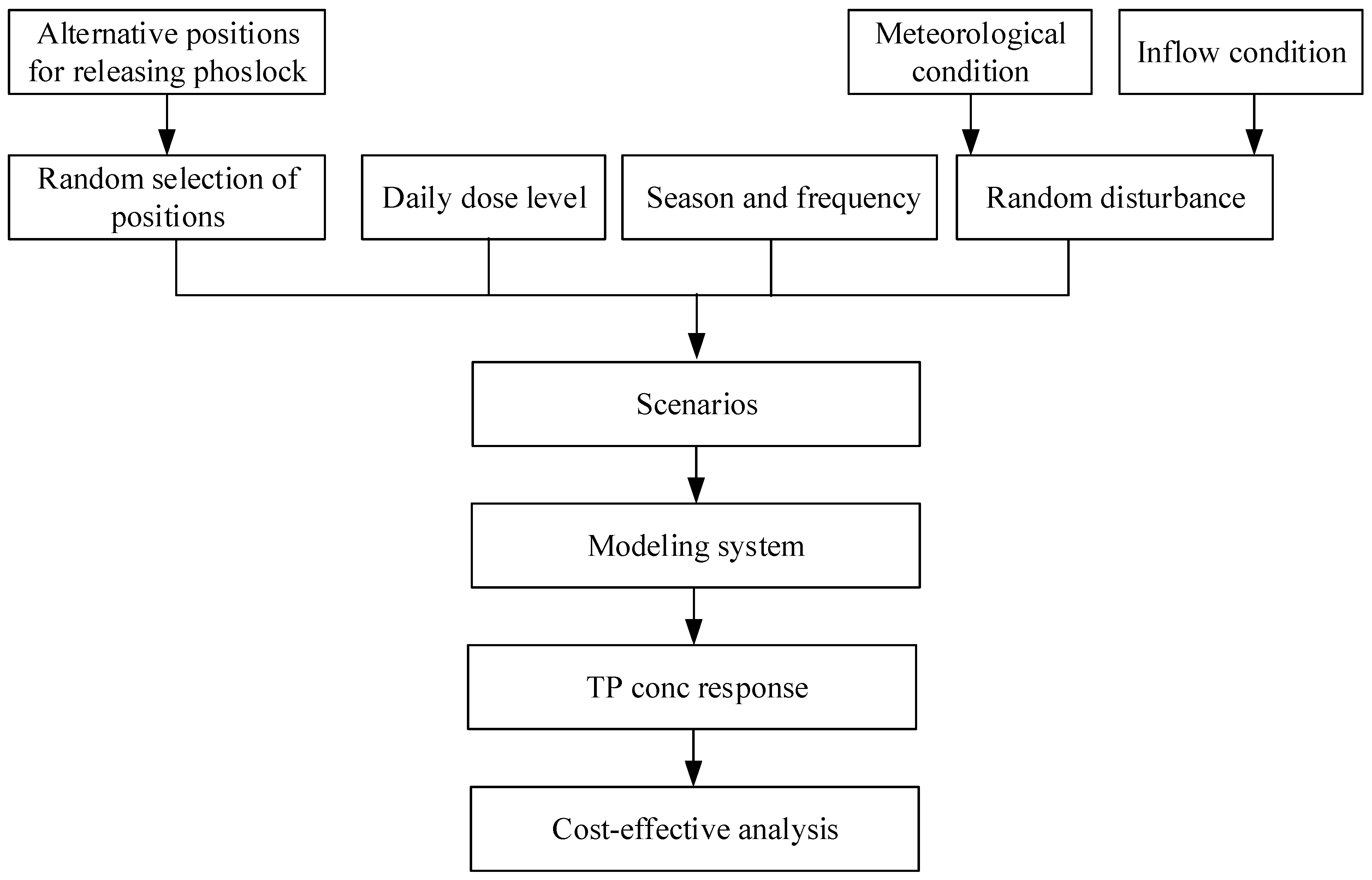
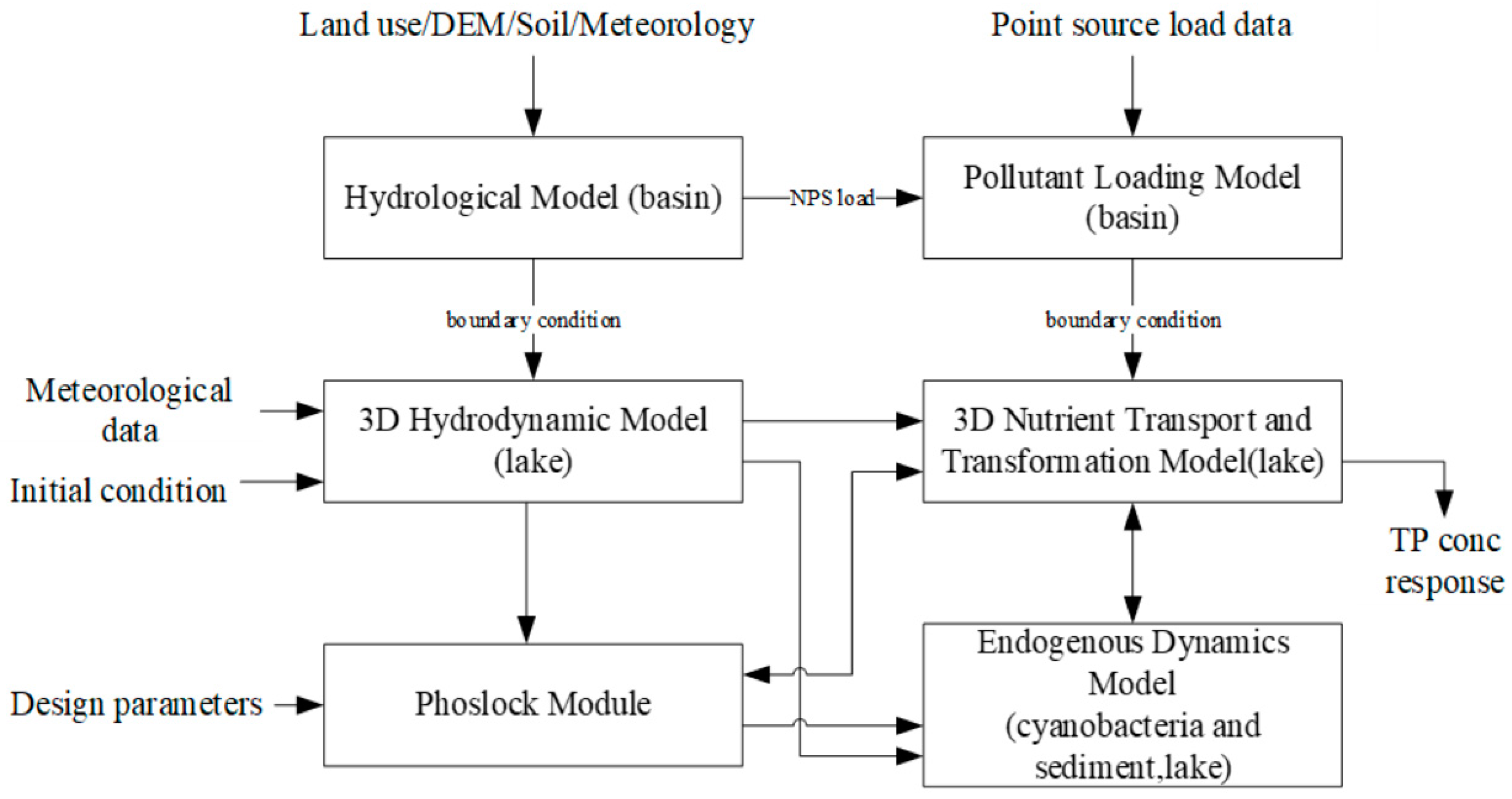
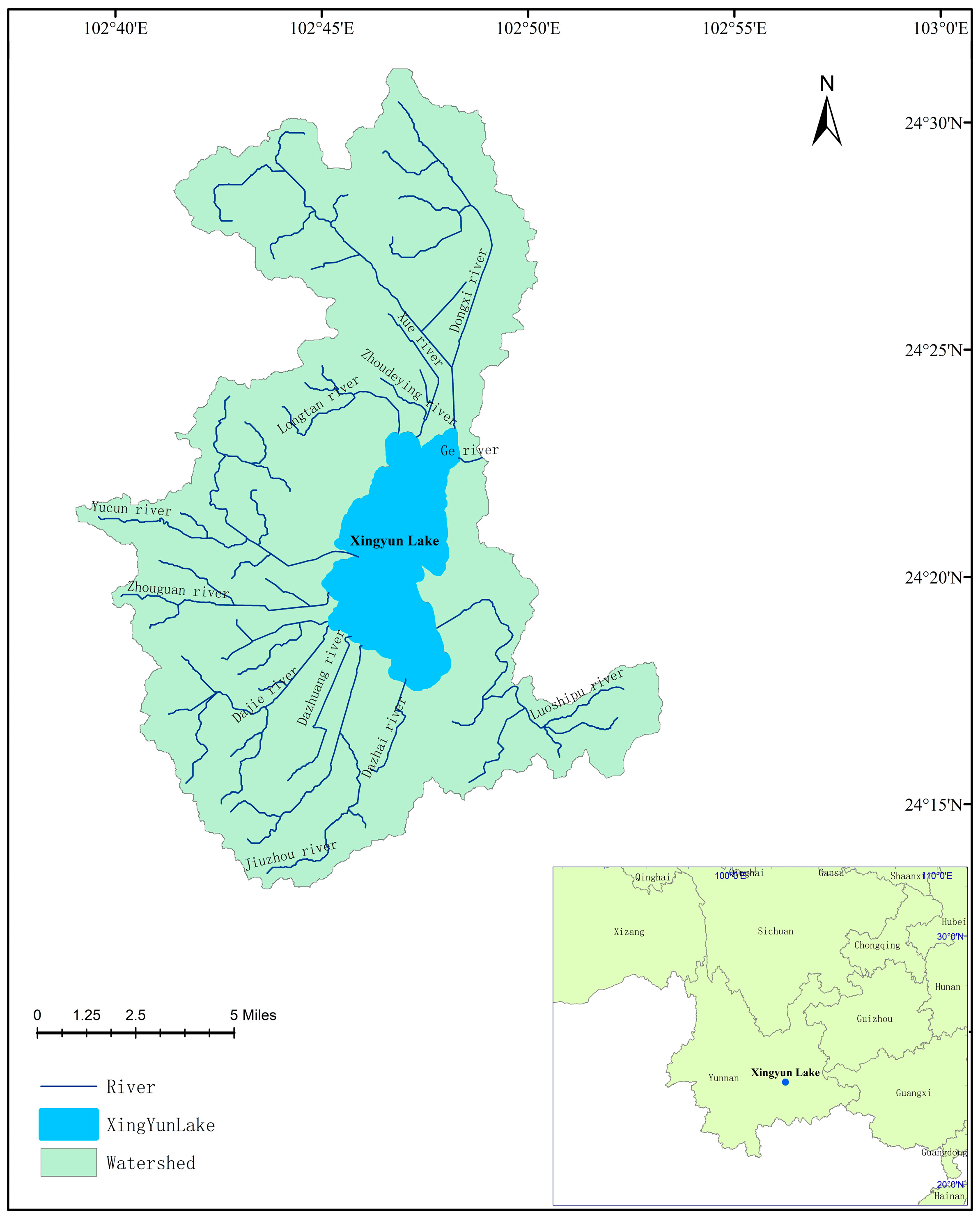
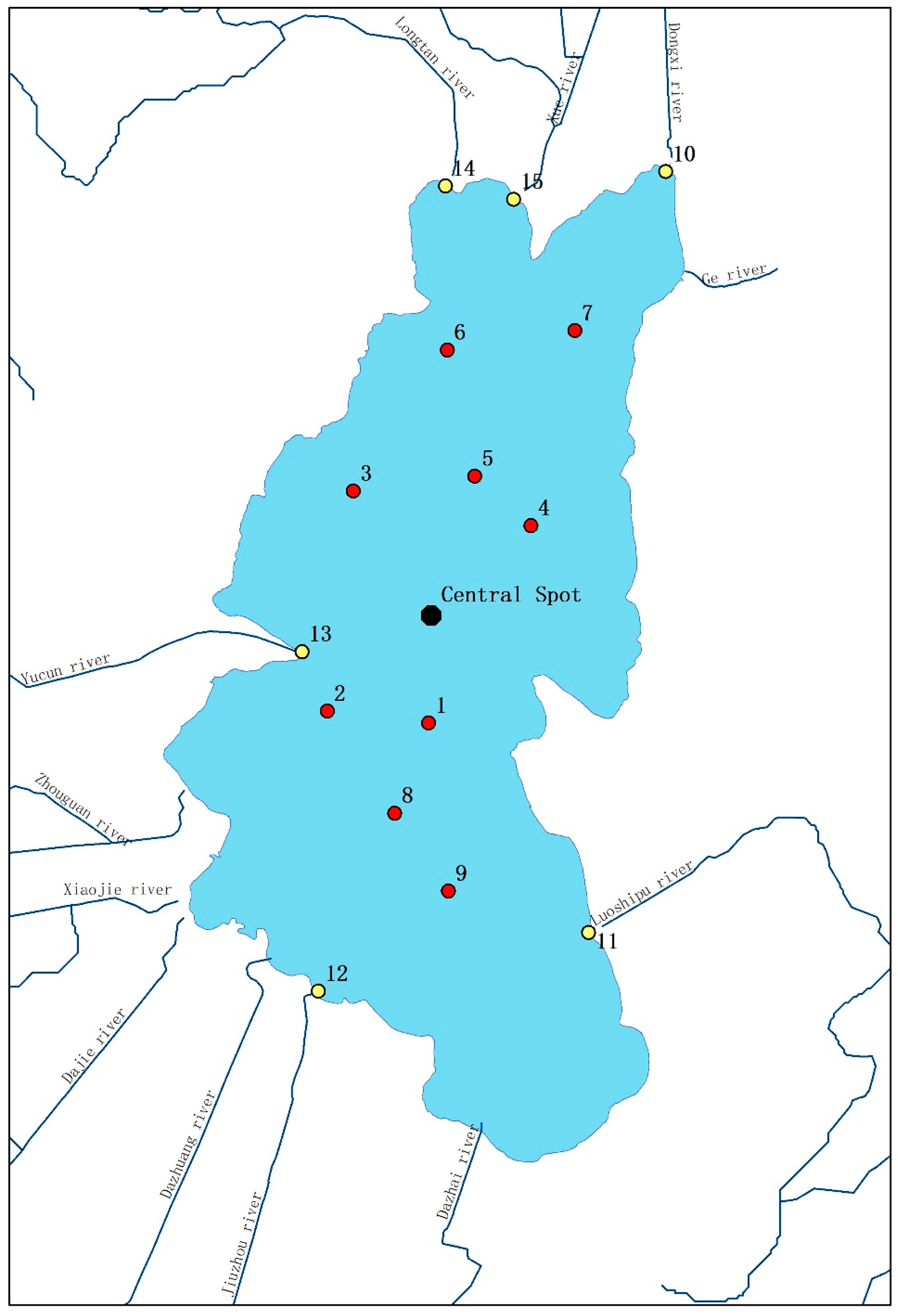
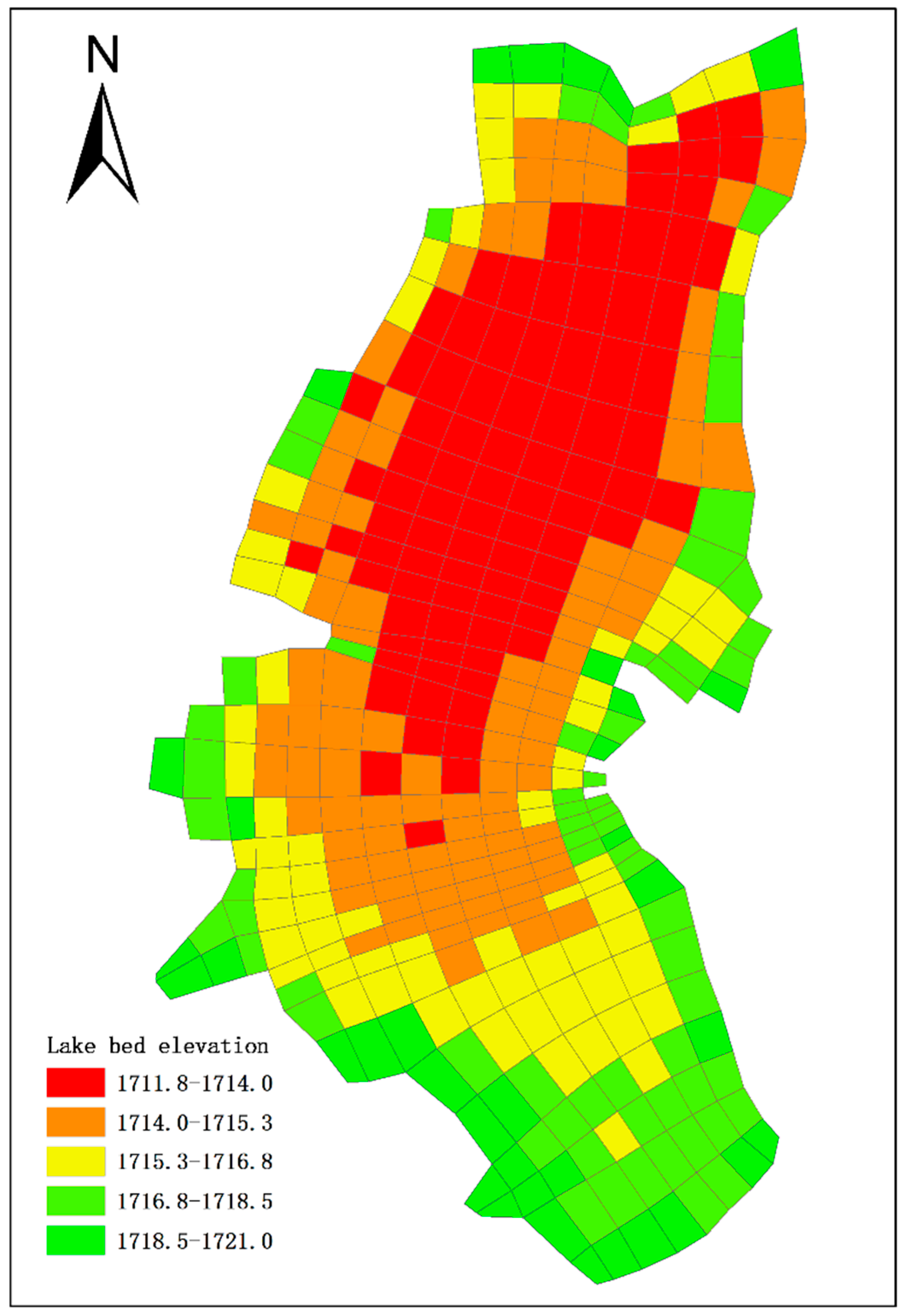
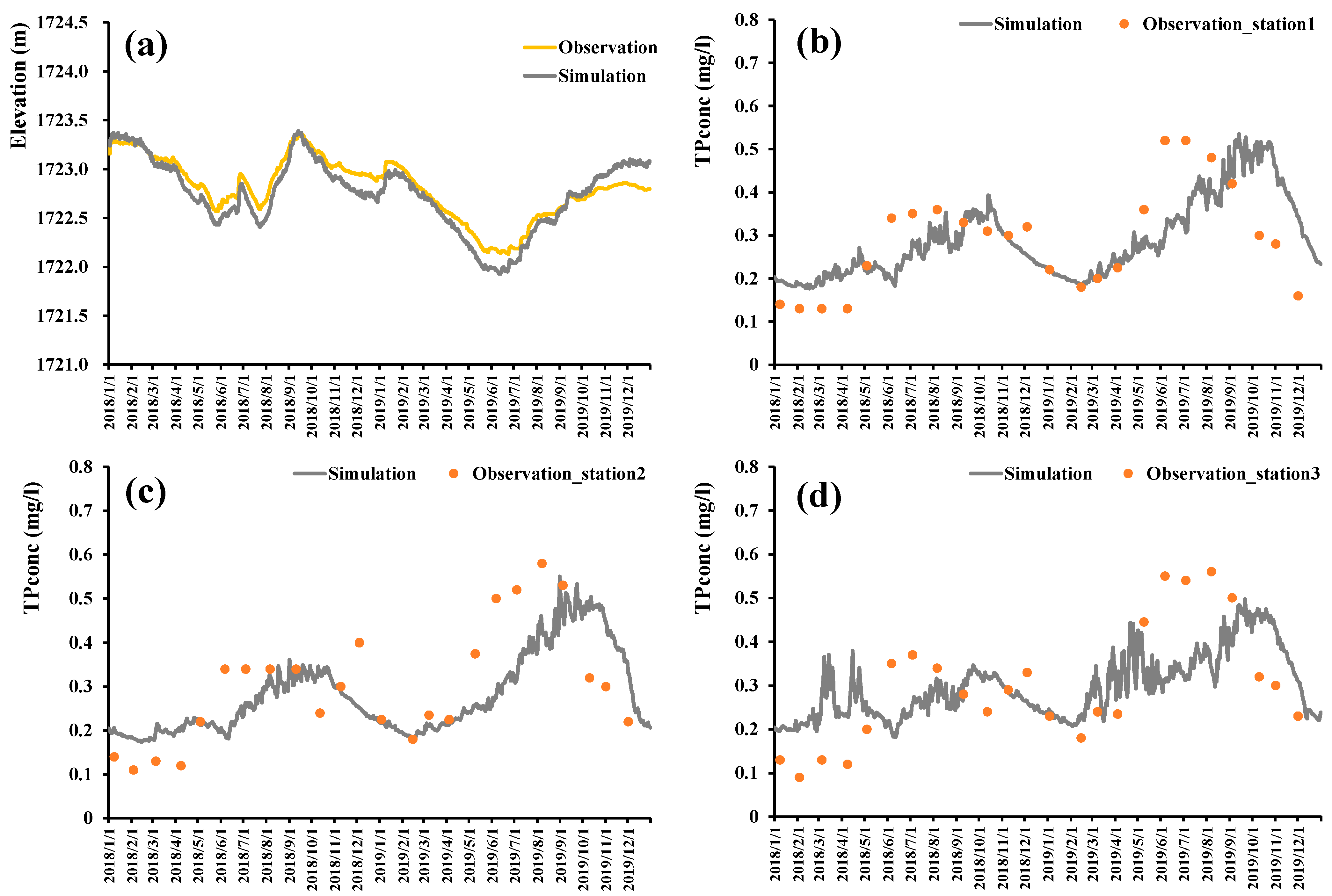
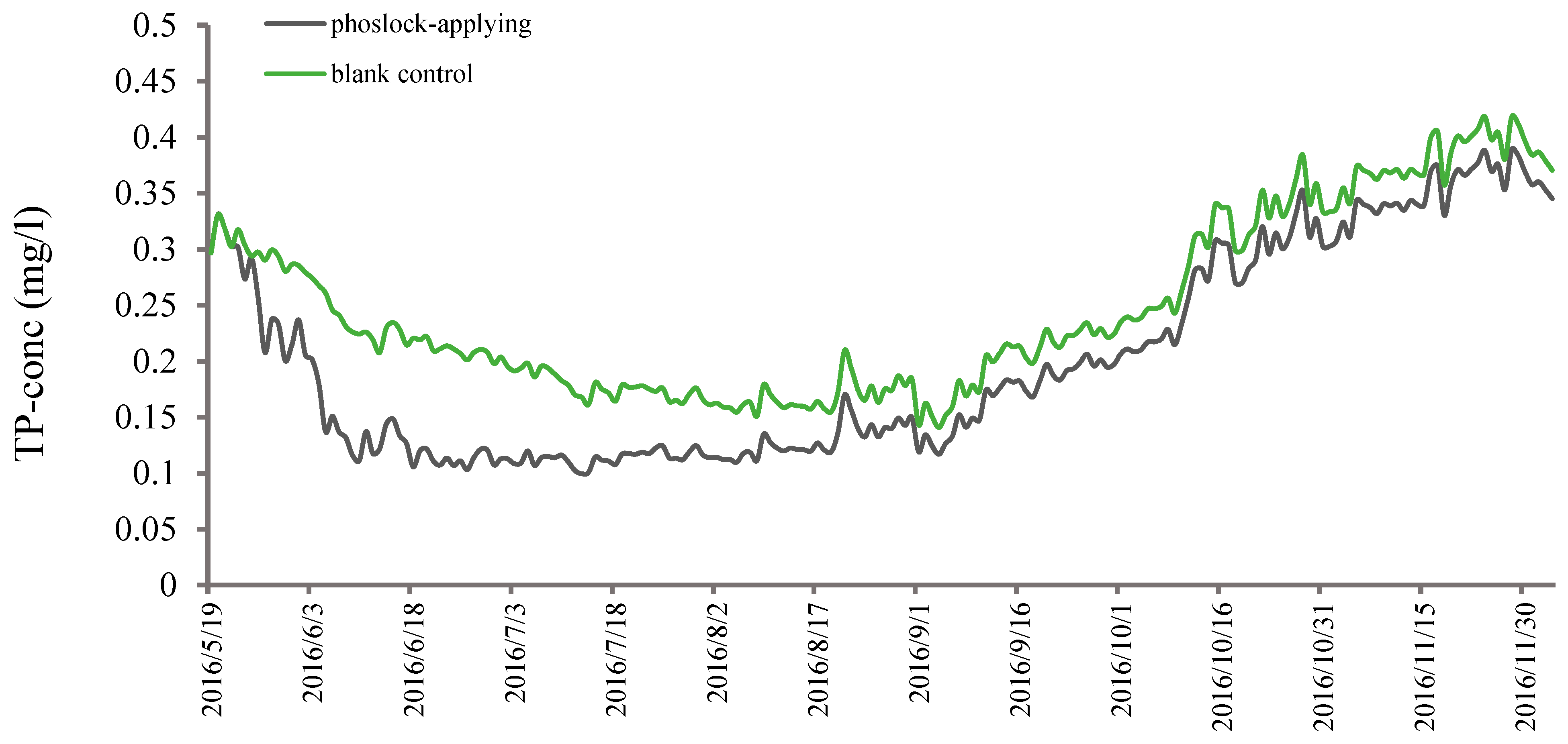
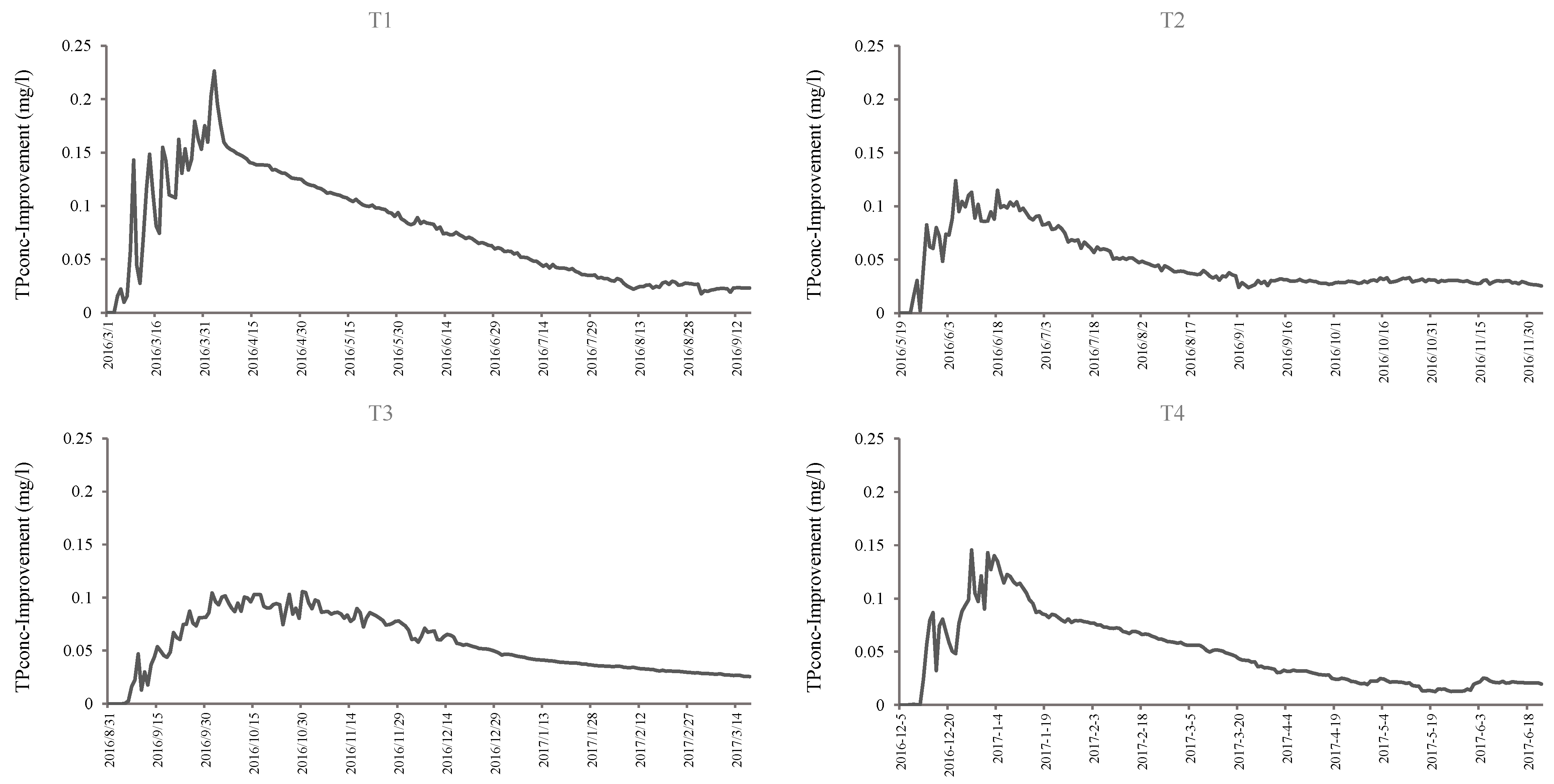
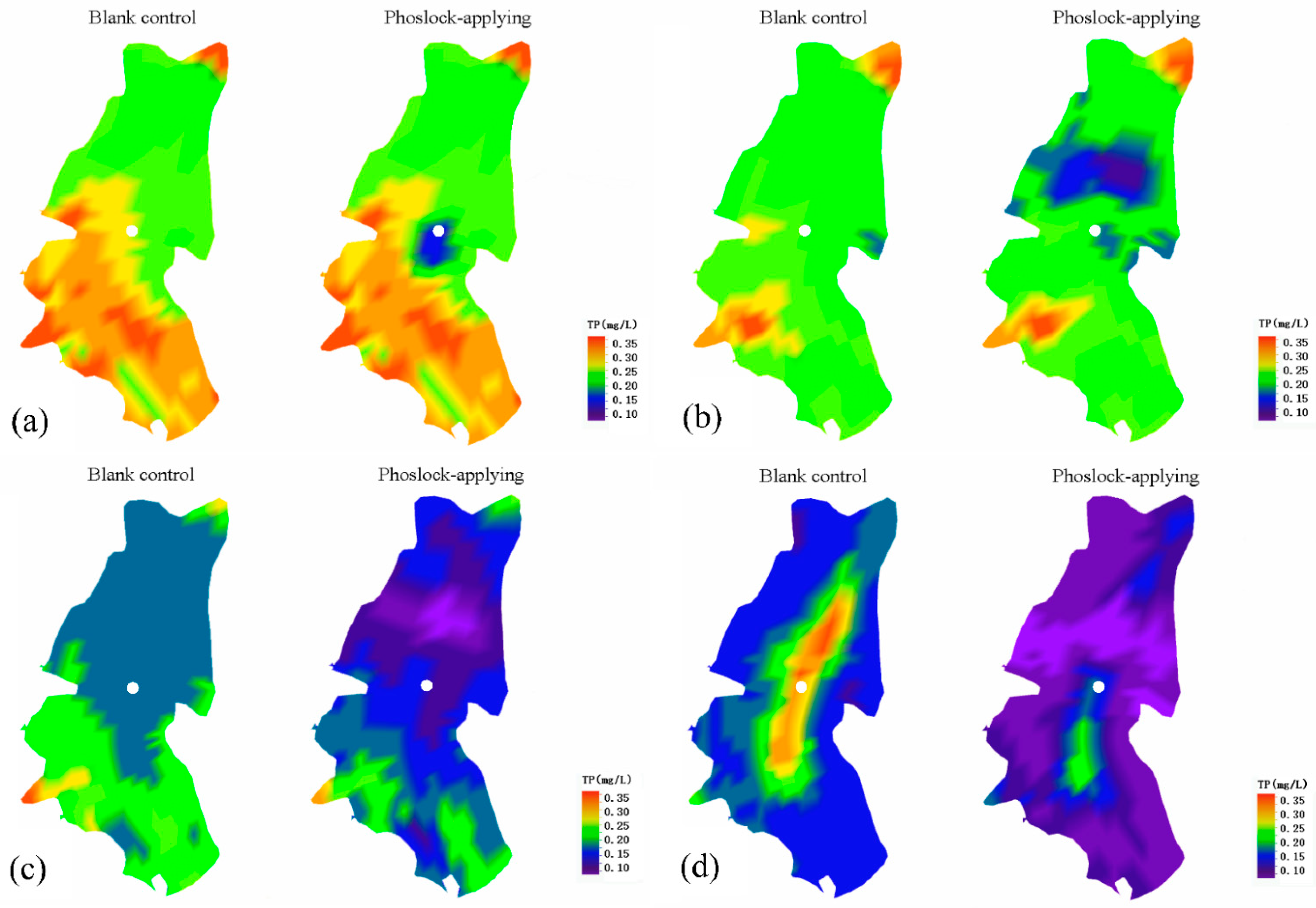

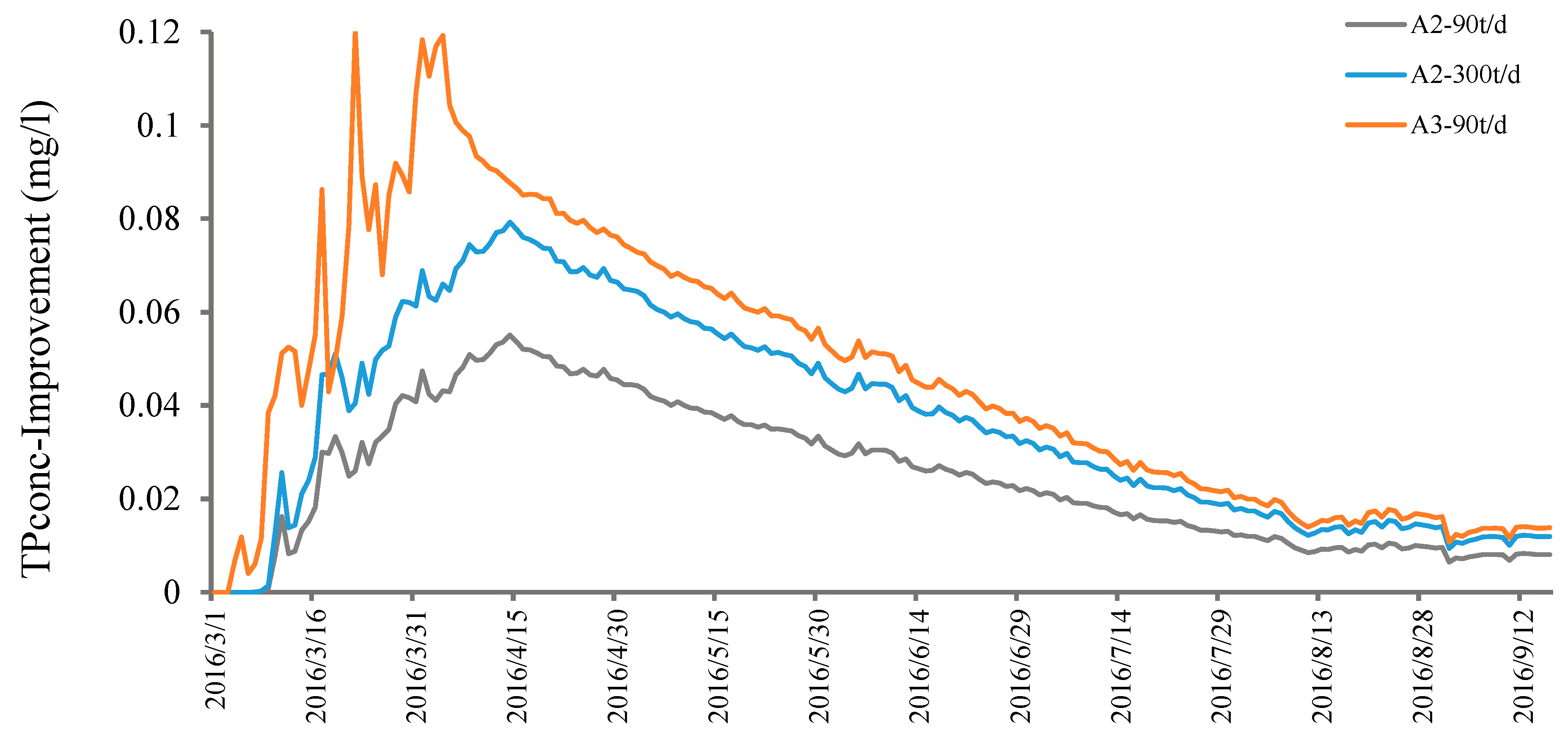
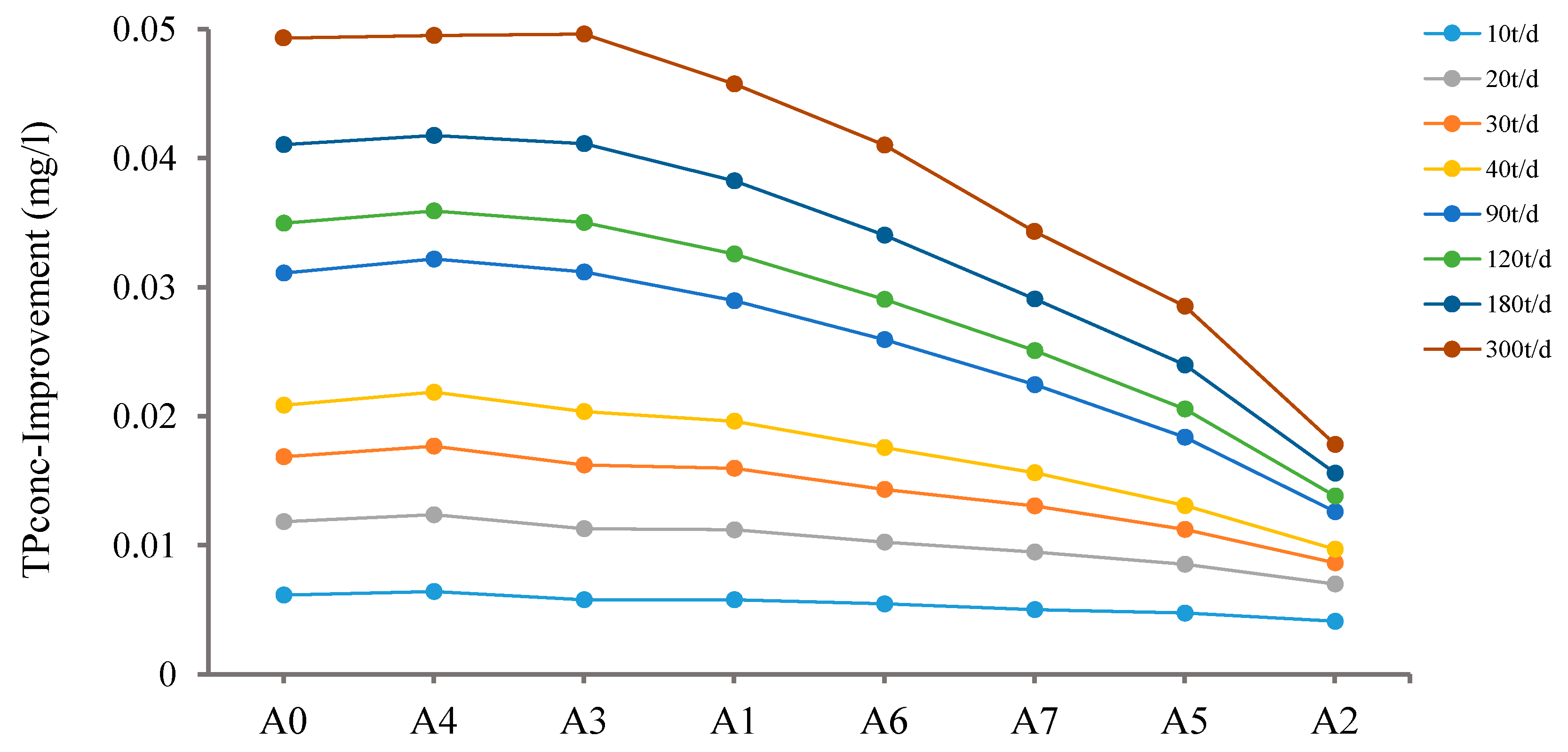
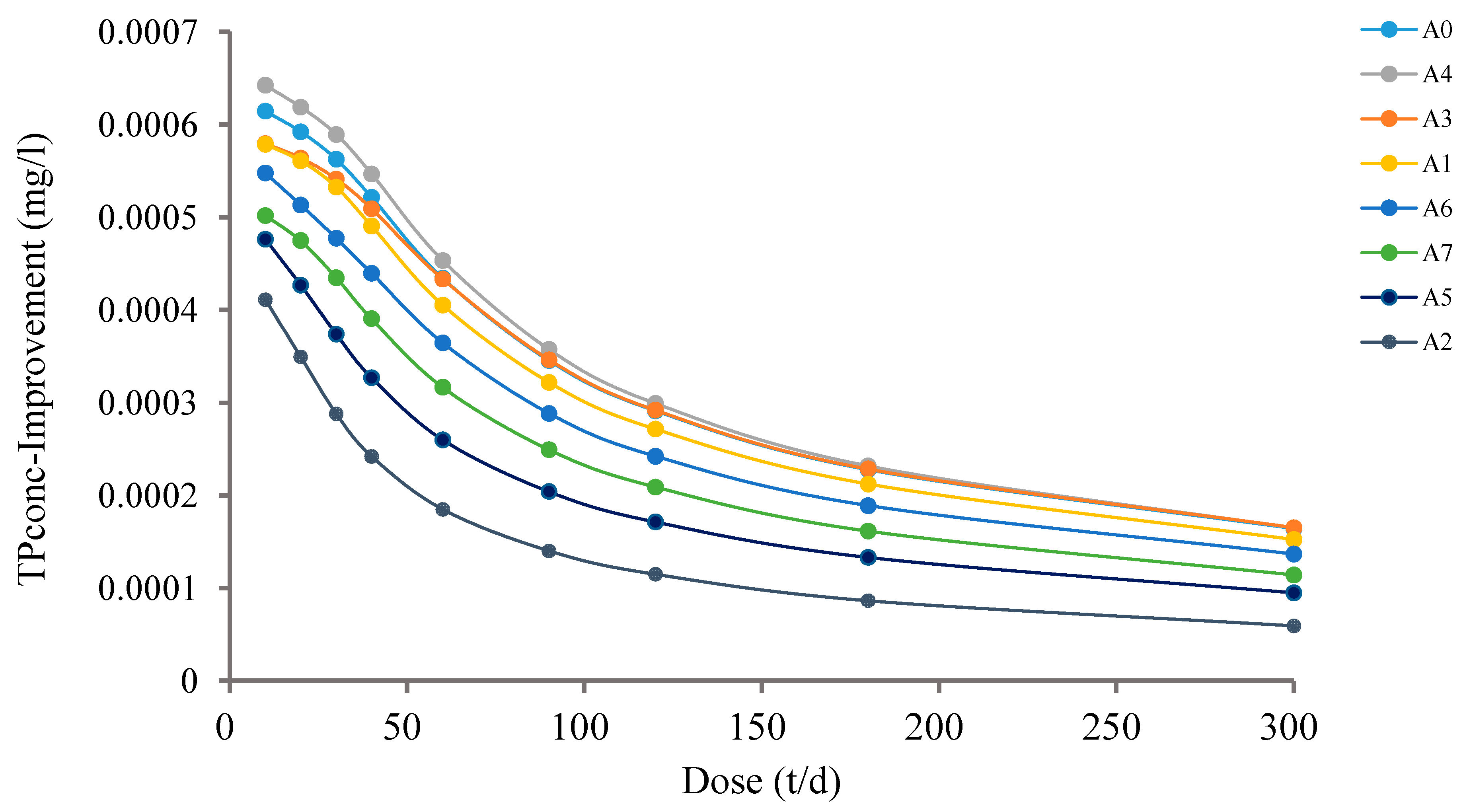
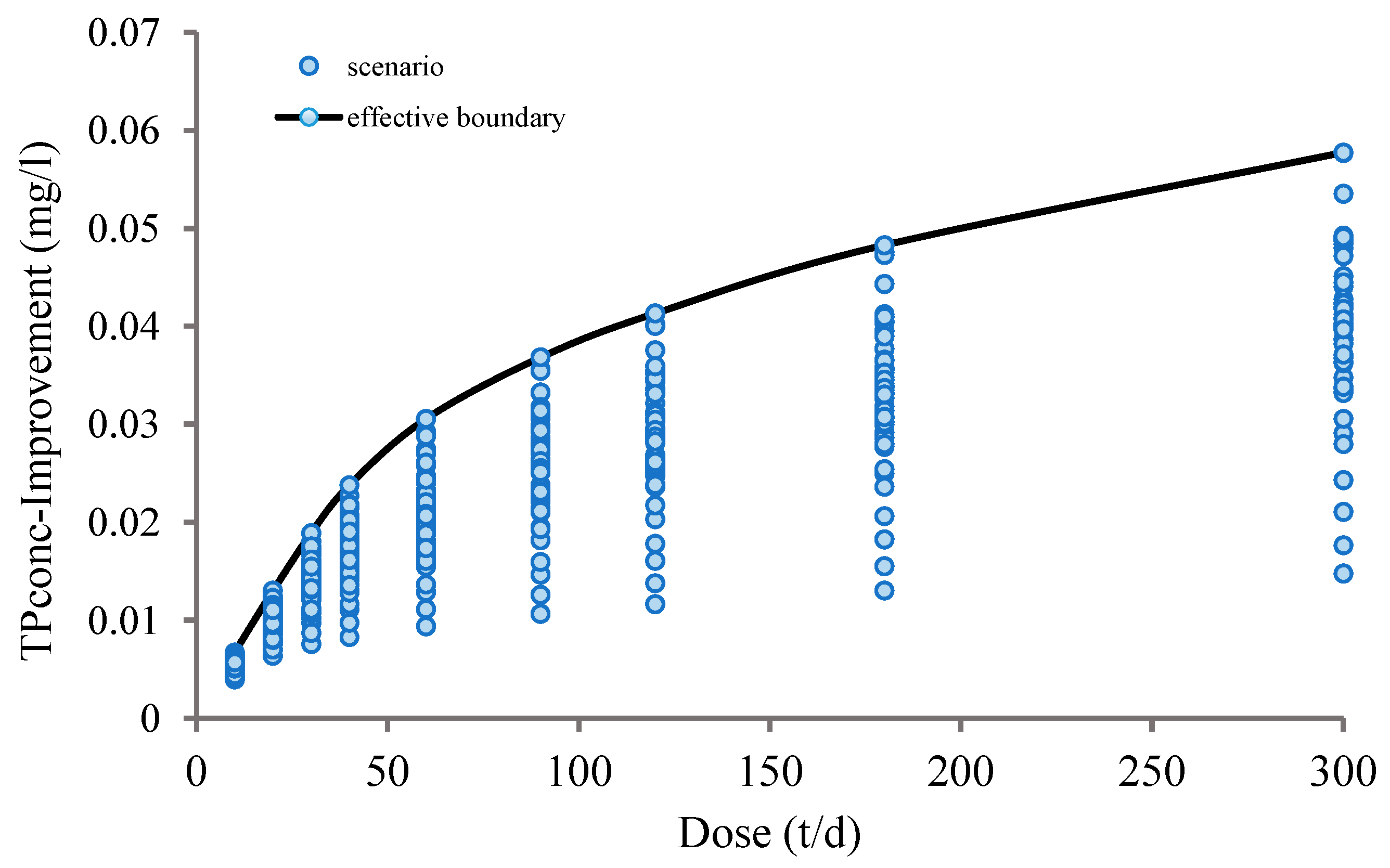
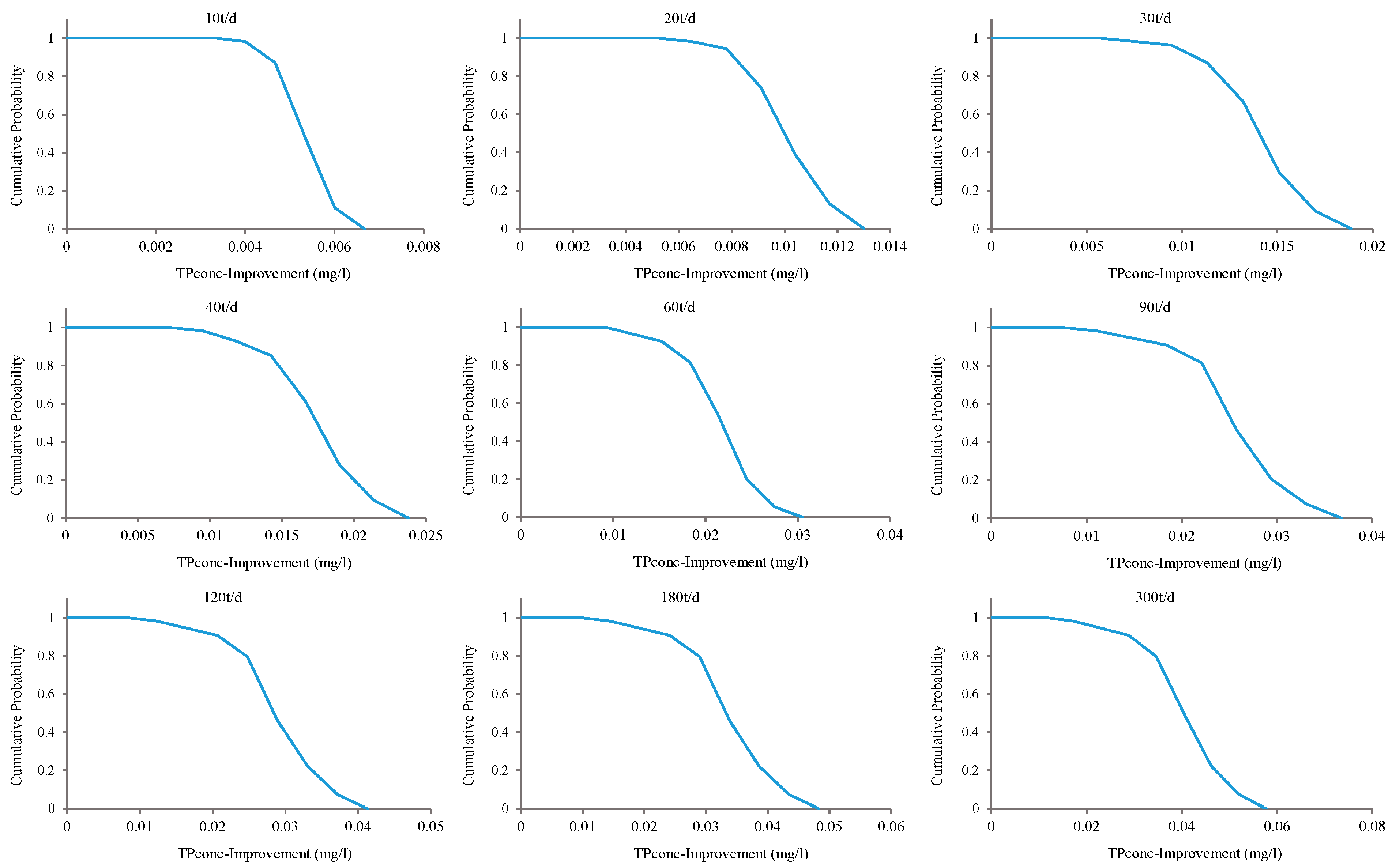
| Domain | Description | Output | Software Available |
|---|---|---|---|
| Basin | Distributed or semi-distributed hydrological model | Flow time series | HSPF, SWAT, LSPC, MIKE SHE+MIKE ECO-Lab, etc. |
| Watershed-scale water quality and nonpoint source (NPS) pollution model | Pollutant flux time series | ||
| Lake | Hydrodynamic simulation | Water level and flow direction time series | EFDC, Delft 3D, MIKE3+MIKE ECO-Lab, etc. |
| Heat exchange simulation | Water temperature time series | ||
| Nutrient transport and transformation simulation | Water quality time series | ||
| Endogenous dynamic simulation | |||
| Simulate dissolution, binding (with phosphate), precipitation process of Phoslock in the lake | _ |
| Season | Sets of Positions | Number of Dose Ranks | Uncertainty Classification | Count |
|---|---|---|---|---|
| First (T1) | 8 (artificial) | 9 (10–300 t/d) | 3 (base 0~base 2) | 216 |
| 10 (random) | 9 (10–300 t/d) | 3 (base 0~base 2) | 270 | |
| Second (T2) | 8 (artificial) | 9 (10–300 t/d) | 3 (base 0~base 2) | 216 |
| 10 (random) | 9 (10–300 t/d) | 3 (base 0~base 2) | 270 | |
| Third (T3) | 8 (artificial) | 9 (10–300 t/d) | 3 (base 0~base 2) | 216 |
| 10 (random) | 9 (10–300 t/d) | 3 (base 0~base 2) | 270 | |
| Fourth (T4) | 8 (artificial) | 9 (10–300 t/d) | 3 (base 0~base 2) | 216 |
| 10 (random) | 9 (10–300 t/d) | 3 (base 0~base 2) | 270 |
| Code Name | Position Numbers |
|---|---|
| A0 | 1, 2, 3, 4, 5 |
| A1 | 1, 2, 3, 4, 13 |
| A2 | 10, 11, 12, 14, 15 |
| A3 | 1, 2, 5, 6, 7 |
| A4 | 2, 3, 4, 5, 13 |
| A5 | 1, 2, 10, 14, 15 |
| A6 | 3, 4, 5, 11, 12 |
| A7 | 1, 2, 10, 13, 15 |
| Dose | Lowest TP Conc Improvement | Worst Scenario | Highest TP Conc Improvement | Cost-Effective Scenario |
|---|---|---|---|---|
| 10 t/d | 0.003955 mg/L | base1-A2 | 0.006676 mg/L | base0-A4 |
| 20 t/d | 0.006356 mg/L | base1-A2 | 0.013003 mg/L | base0-A4 |
| 30 t/d | 0.007541 mg/L | base1-A2 | 0.018867 mg/L | base0-A4 |
| 40 t/d | 0.008267 mg/L | base1-A2 | 0.023763 mg/L | base0-A4 |
| 60 t/d | 0.009361 mg/L | base1-A2 | 0.030537 mg/L | base0-A4 |
| 90 t/d | 0.010631 mg/L | base1-A2 | 0.036812 mg/L | base0-A4 |
| 120 t/d | 0.011614 mg/L | base1-A2 | 0.041296 mg/L | base0-A4 |
| 180 t/d | 0.013029 mg/L | base1-A2 | 0.048266 mg/L | base0-A4 |
| 300 t/d | 0.014773 mg/L | base1-A2 | 0.057726 mg/L | base0-A3 |
Publisher’s Note: MDPI stays neutral with regard to jurisdictional claims in published maps and institutional affiliations. |
© 2021 by the authors. Licensee MDPI, Basel, Switzerland. This article is an open access article distributed under the terms and conditions of the Creative Commons Attribution (CC BY) license (http://creativecommons.org/licenses/by/4.0/).
Share and Cite
Zhang, B.; Lin, N.; Chen, X.; Fan, Q.; Chen, X.; Ren, T.; Zou, R.; Guo, H. Nonlinear Water Quality Response to Numerical Simulation of In Situ Phosphorus Control Approaches. Water 2021, 13, 725. https://doi.org/10.3390/w13050725
Zhang B, Lin N, Chen X, Fan Q, Chen X, Ren T, Zou R, Guo H. Nonlinear Water Quality Response to Numerical Simulation of In Situ Phosphorus Control Approaches. Water. 2021; 13(5):725. https://doi.org/10.3390/w13050725
Chicago/Turabian StyleZhang, Baichuan, Ningya Lin, Xi Chen, Qiaoming Fan, Xing Chen, Tingyu Ren, Rui Zou, and Huaicheng Guo. 2021. "Nonlinear Water Quality Response to Numerical Simulation of In Situ Phosphorus Control Approaches" Water 13, no. 5: 725. https://doi.org/10.3390/w13050725
APA StyleZhang, B., Lin, N., Chen, X., Fan, Q., Chen, X., Ren, T., Zou, R., & Guo, H. (2021). Nonlinear Water Quality Response to Numerical Simulation of In Situ Phosphorus Control Approaches. Water, 13(5), 725. https://doi.org/10.3390/w13050725







